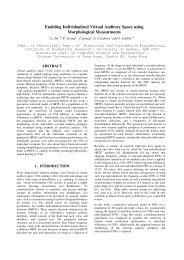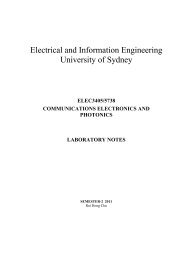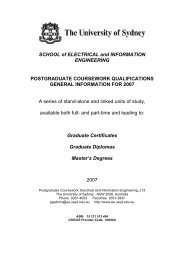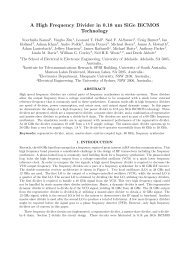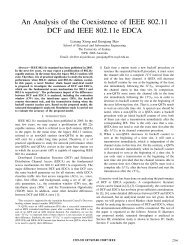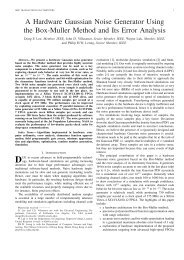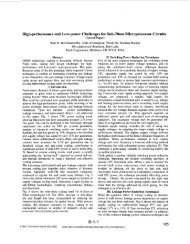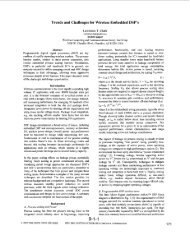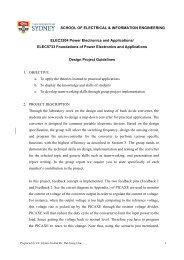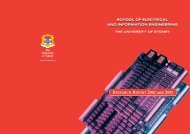Near-capacity turbo trellis coded modulation design based on union ...
Near-capacity turbo trellis coded modulation design based on union ...
Near-capacity turbo trellis coded modulation design based on union ...
Create successful ePaper yourself
Turn your PDF publications into a flip-book with our unique Google optimized e-Paper software.
2034 IEEE TRANSACTIONS ON COMMUNICATIONS, VOL. 56, NO. 12, DECEMBER 2008<br />
Bit 2<br />
Bit 1<br />
Fig. 3.<br />
Recursive Systematic C<strong>on</strong>voluti<strong>on</strong>al Encoder<br />
g 2 = [0100] 2<br />
g 1 = [0010] 2<br />
D<br />
g r = [1011] 2<br />
D<br />
G =[g r g 1 g 2 ] 8 =[1324] 8<br />
TCM c<strong>on</strong>stituent comp<strong>on</strong>ent code.<br />
D<br />
Bit 2<br />
Bit 1<br />
Bit 0<br />
We note that the extrinsic and the systematic informati<strong>on</strong><br />
associated with each a posteriori TTCM symbol probability at<br />
the output of a c<strong>on</strong>stituent TCM decoder cannot be separated,<br />
since the systematic and parity bits of a TTCM en<str<strong>on</strong>g>coded</str<strong>on</strong>g><br />
symbol are transmitted together in a modulated symbol over<br />
the communicati<strong>on</strong> channels [4], [6]. However, we have to<br />
extract the extrinsic informati<strong>on</strong> from the a posteriori symbol<br />
probability in order to generate the corresp<strong>on</strong>ding symbol<str<strong>on</strong>g>based</str<strong>on</strong>g><br />
EXIT chart [31]. Hence, the assumpti<strong>on</strong> that the extrinsic<br />
and systematic informati<strong>on</strong> are independent of each other is<br />
needed [31], so that the extrinsic informati<strong>on</strong> may be extracted<br />
from the a posteriori symbol probability. N<strong>on</strong>etheless, despite<br />
the limited validity of the above-menti<strong>on</strong>ed independence, we<br />
will show in Secti<strong>on</strong> VI that accurate code <str<strong>on</strong>g>design</str<strong>on</strong>g> is still<br />
possible with the aid of the resultant EXIT charts.<br />
An efficient method devised for generating symbol-<str<strong>on</strong>g>based</str<strong>on</strong>g><br />
EXIT charts from symbol-<str<strong>on</strong>g>based</str<strong>on</strong>g> a posteriori probabilities<br />
(APPs) was proposed in [23]. This technique is <str<strong>on</strong>g>based</str<strong>on</strong>g> <strong>on</strong> the<br />
fact that the symbol-<str<strong>on</strong>g>based</str<strong>on</strong>g> APPs generated at the output of a<br />
SISO decoder represent sufficient statistics for all observati<strong>on</strong>s<br />
(channel and aprioriinformati<strong>on</strong>) at its input. More specifically,<br />
the average extrinsic informati<strong>on</strong> I E (u) at the output of<br />
the APPs decoder can be computed as [23]:<br />
[<br />
I E (u) =log 2 (M) − 1 N∑ M<br />
]<br />
∑<br />
E e(u (i)<br />
k<br />
N<br />
)log 2(e(u (i)<br />
k ))<br />
k=1<br />
i=1<br />
(20)<br />
where N is the number of informati<strong>on</strong> symbols in the decoding<br />
block, M =2 m is the cardinality of the m-bit informati<strong>on</strong><br />
symbol, u (i)<br />
k<br />
is the hypothetically transmitted informati<strong>on</strong><br />
symbol at time instant k for i ∈{1, 2,...,M}, e([.]) is the<br />
extrinsic probability of symbol [.] and the expectati<strong>on</strong> can<br />
be approximated by simple time-averaging of the extrinsic<br />
probabilities of the informati<strong>on</strong> symbol. As an advantage, the<br />
symbol-<str<strong>on</strong>g>based</str<strong>on</strong>g> extrinsic mutual informati<strong>on</strong> can be computed<br />
using Eq. (20) at a c<strong>on</strong>siderably lower complexity compared<br />
to the c<strong>on</strong>venti<strong>on</strong>al histogram-<str<strong>on</strong>g>based</str<strong>on</strong>g> approach.<br />
V. CONSTITUENT CODE SEARCH<br />
Let us first c<strong>on</strong>sider the RSC encoder structure of a c<strong>on</strong>stituent<br />
TCM comp<strong>on</strong>ent code seen in Fig. 3, which depicts<br />
the RSC encoder used by the c<strong>on</strong>stituent TCM comp<strong>on</strong>ent<br />
code of an 8-state 8PSK-<str<strong>on</strong>g>based</str<strong>on</strong>g> TTCM scheme. The number<br />
of informati<strong>on</strong> bits per symbol is m =2and there is <strong>on</strong>ly<br />
<strong>on</strong>e parity bit in each TCM en<str<strong>on</strong>g>coded</str<strong>on</strong>g> symbol. Hence, the code<br />
rate is R = m/(m +1). The c<strong>on</strong>necti<strong>on</strong>s shown in Fig. 3<br />
between the informati<strong>on</strong> bits and the modulo-2 adders are<br />
given by the GPs. The feed-forward GPs are denoted as g i<br />
for i ∈ {1, 2 ...,m}, while the feed-back GP is denoted<br />
as g r . As shown in Fig. 3, there are 4 possible c<strong>on</strong>necti<strong>on</strong><br />
points, when there are three shift register stages, each denoted<br />
by D. The four binary digits seen in the GPs indicate the<br />
presence or absence of c<strong>on</strong>necti<strong>on</strong>s. For example, the GP<br />
corresp<strong>on</strong>ding to the first informati<strong>on</strong> bit, namely Bit 1, is<br />
given by g 1 = [0010] 2 , which indicates that Bit 1 is c<strong>on</strong>nected<br />
<strong>on</strong>ly to the modulo-2 adders that is third from the left. Note<br />
that we follow <strong>on</strong>e of the rules provided in [1], where the rightmost<br />
c<strong>on</strong>necti<strong>on</strong> point is c<strong>on</strong>nected to the parity bit <strong>on</strong>ly, so<br />
that all the paths diverging from a comm<strong>on</strong> <str<strong>on</strong>g>trellis</str<strong>on</strong>g> state are<br />
associated with codewords having the same parity bit, but at<br />
least <strong>on</strong>e different systematic bit [1]. The code GP is expressed<br />
in octal format as G =[g r g 1 g 2 ] 8 =[1324] 8 .<br />
The c<strong>on</strong>stituent TCM code search used for finding meritorious<br />
TTCM schemes was originally <str<strong>on</strong>g>based</str<strong>on</strong>g> <strong>on</strong> the ‘punctured’<br />
minimal distance criteri<strong>on</strong> [4]. However, we found that a<br />
c<strong>on</strong>stituent code having the ‘punctured’ maximal minimal<br />
distance guaranteed the highest coding gain <strong>on</strong>ly during the<br />
first <str<strong>on</strong>g>turbo</str<strong>on</strong>g> iterati<strong>on</strong>, but it was unable to always guarantee<br />
a decoding c<strong>on</strong>vergence at the lowest possible SNR value.<br />
By c<strong>on</strong>trast, the EXIT chart characteristics had the ability to<br />
predict decoding c<strong>on</strong>vergence, where decoding c<strong>on</strong>vergence<br />
is indicated by having an open tunnel between the two EXIT<br />
chart curves [21]. Therefore, the ‘punctured’ maximal minimal<br />
distance is no l<strong>on</strong>ger the prime criteri<strong>on</strong>, when <str<strong>on</strong>g>design</str<strong>on</strong>g>ing<br />
<str<strong>on</strong>g>capacity</str<strong>on</strong>g>-approaching TTCM schemes. Instead, the prime <str<strong>on</strong>g>design</str<strong>on</strong>g><br />
criteri<strong>on</strong> is to find a c<strong>on</strong>stituent TCM code, where the<br />
corresp<strong>on</strong>ding EXIT charts exhibit an open tunnel at the lowest<br />
possible SNR value, as well as an acceptable error floor<br />
as estimated by the symbol-<str<strong>on</strong>g>based</str<strong>on</strong>g> uni<strong>on</strong> bound outlined in<br />
Secti<strong>on</strong> III.<br />
Since maximising the minimal distance is no l<strong>on</strong>ger the<br />
main <str<strong>on</strong>g>design</str<strong>on</strong>g> objective, we can predefine the GP c<strong>on</strong>necti<strong>on</strong>s<br />
of the informati<strong>on</strong> bits and then <strong>on</strong>ly search for the best GP<br />
creating the parity bit. On <strong>on</strong>e hand, using different GPs for<br />
the informati<strong>on</strong> bits may result in a different optimal paritybit<br />
GP. On the other hand, we found that having a single<br />
c<strong>on</strong>necti<strong>on</strong> for each of the informati<strong>on</strong> bits to a single distinct<br />
modulo-2 adder, as in Fig. 3, and then searching for the best<br />
parity-bit GP, namely g r , had the potential of providing us<br />
with c<strong>on</strong>stituent TCM comp<strong>on</strong>ent codes creating near-<str<strong>on</strong>g>capacity</str<strong>on</strong>g><br />
TTCM schemes. When the number of modulo-2 c<strong>on</strong>necti<strong>on</strong>s<br />
for each of the informati<strong>on</strong> bits to the shift registers is set<br />
to <strong>on</strong>e, the correlati<strong>on</strong> between the informati<strong>on</strong> bits and the<br />
parity bit is minimised. Hence the potential EXIT chart and<br />
decoding-trajectory mismatch may be reduced. Furthermore,<br />
when the GPs of the m number of systematic informati<strong>on</strong><br />
bits are predefined, the search space is reduced from 2 mν to<br />
2 ν ,whereν is the number of shift register stages. Since each<br />
informati<strong>on</strong> bit may <strong>on</strong>ly have a distinct c<strong>on</strong>necti<strong>on</strong> to a single<br />
modulo-2 adder, the minimum number of shift register stages<br />
required equals the number of informati<strong>on</strong> bits, i.e. we have<br />
ν = m.<br />
Authorized licensed use limited to: UNIVERSITY OF SYDNEY. Downloaded <strong>on</strong> January 4, 2009 at 20:22 from IEEE Xplore. Restricti<strong>on</strong>s apply.



